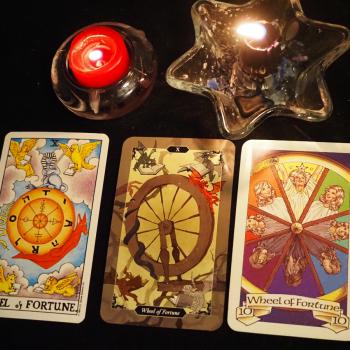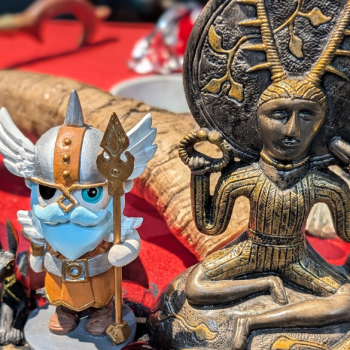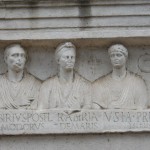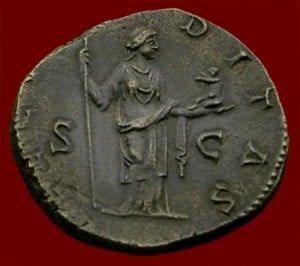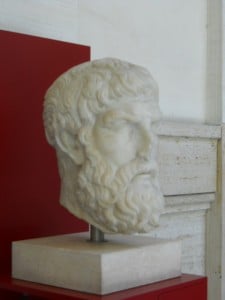A front door safeguards what is inside by barring whatever is outside. The Romans protected their doorways with a little religion, a little magic, and something that was a little of both.
Foremost are the religious rites due to the minor gods of the doorway – Janus Janitor, Forculus, Cardea, Limitaninus and Limitanina. Just inside the front door is the lararium, a shrine for the family Lares and patron deities. Daily rites are provided for the Lares at their lararium, which is the main focal point for domestic worship. The ancestral Lares, patron deities, and the minor gods of the doorway defend the home from the Umbrae who are the inferior Manes of the Avernus underworld.
In my earlier post I mentioned the placement of a branch of hawthorn above a doorway as a protective amulet. Its purpose is to snag any evil that might approach the home and thus keep it away. Hawthorn was also place in the windows of children rooms for the same purpose, and a number of other herbs, stones, or wood would be used to repel evil. At the same time certain sweet-smelling herbs – anise, lemon balm and the like, would be hung near doorways and windows so that their pleasant smells might attract good. Certain trees were especially associated with Gods; oak with Jupiter, poplar with Hercules, olive with Minerva, laurel with Apollo, juniper and cedar with Juno, and so on. A post of such wood, or devices made from them and bound with wool threads could be hung as a means of attracting the power of a protective deity. Thus crossed twigs of oak, wound with red wool, might be placed near a doorway to invoke the numen of Jupiter. Even more effective could be wood struck by a lightning bolt, as the power of Jupiter would be within it. At the same time beneficial herbs might be hung from such a device to enhance its presence as a protective amulet.
For those who could afford it among the ancients, a mosaic might be laid inside the entrance. Some mosaics that have been preserved show a maze at the center of which is a medallion of Theseus slaying the Minotaur. Others show a a maze in the form of a web of interlocking circles, at the center of which is a head of Medusa. In the opening credits for the first season of HBO’s series Rome an animated Medusa is seen no doubt to evoke just this kind of spirit trap. Any Umbrae that came upon such designs would follow the course of the maze or web, leading down to a scene that would frighten them away or otherwise trap and slay them.
For those who could not afford a fine mosaic, there was another device to use as a spirit trap. From Conimbriga, Portugal, in the south to Manchester in the north, and as far east as Dura Europus in Syria, there is a recurring word puzzle:
ROTAS
OPERA
TENET
AREPO
SATOR
Recognizing some Latin words in the inscription, some have wracked their brains trying to make sense of its meaning – which demonstrates exactly how this device works against the Umbrae. It is a nonsensical puzzle, and a palindrome. The letters form into a square to resemble a fort. In consternation the Umbrae look over the inscription like barbarians studying a Roman camp. Discouraged, they then move on to the next door. Or maybe it is that they are stalled, trying to figure out the puzzle, just long enough for the family Lares to gather in defense of the doorway. These devices are usually found inscribed or scratched on a door sill outside of the house, although they have been found on walls, and even on a roof tile in one case.
The Romans did not rely on spirit traps alone to defend their houses; spirits traps of these kind are relatively rare. Very common were red phalli hung above a door, representing Faunus or Priapus, as a kind of threat to skewer any evil or anyone who intended evil. One home owner at Pompeii even erected a brightly painted red phallus, three feet tall, out in front of his doorway to keep evil at bay. Then inside a doorway would be placed a number of tintinnabelli that served two purposes. Sometimes these bronze amulets take the form of a grotesque dwarf or animal with an overly large phallus, sometimes they show Mercury with multiple phalli, and at other times it may simply be a winged phallus, and all of them, as their name implies, had many bronze bells hanging from them. The phalli indicate good fortune. Some occur with an inscription: “Happiness dwells here; let no evil enter.” The comic nature of many of the tintinnabelli were intended to evoke laughter. Laughter is an effective way to drive off evil. And the bells themselves, like wind chimes and the tinkling of bells used in many traditions, provide a pleasant sound that again drives away ill winds.
The most effective way to keep evil at bay is to use laughter anytime you opened your front door. For that reason the Romans sometimes placed a mural just inside a doorway with a bawdy scene that once again was intended to evoke laughter from any arriving guests. Of course another option was to place a mural of a religious scene inside a doorway in order to evoke a more reverent atmosphere, while still others preferred scenes from myths, or of favorite authors, perhaps sport scenes, all with an intent to draw a pleasant atmosphere to just inside the house, at the same time that other decorations and amulets placed outside the doorway kept away anything that might bring ill-will into the home.
The walls of a house form the boundary between a sacred space within and the mundane outside. A doorway is the passageway to enter the sacred space. So whether a temple or a family home, the front door is safeguarded in many ways to invite in good health, good fortune, and good friends, while repelling anything that would bring harm. Herbs and flowers, charms and amulets, offerings for the Gods, and decorations all serve their own purposes to safeguard the home. It is no different than with other traditions. Inscribed words from the Qoran or the Torah placed on a door post, or a crucifix hung above a door, wind chimes and Indian bells, dream catchers and front door wreathes are all related to ancient practices. The cultores Deorum who practice the religio Romana retain such practices as well, based in our own ancient traditions, to invoke the Gods into our homes, our sacred spaces, that They may share in our lives.




